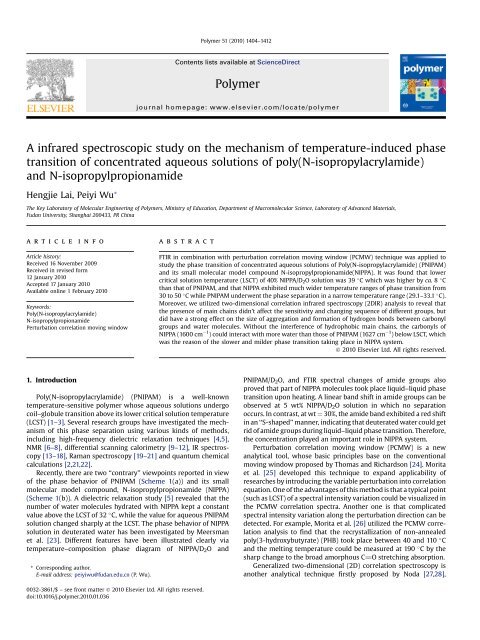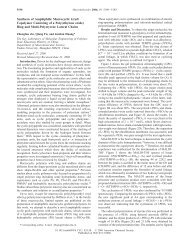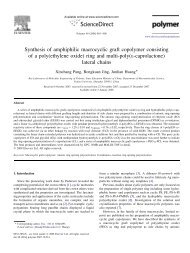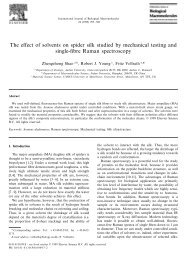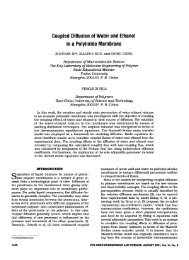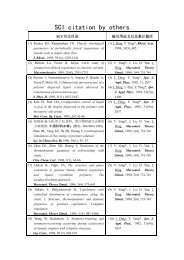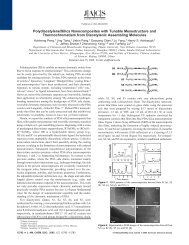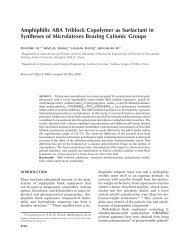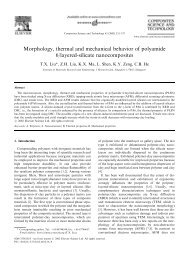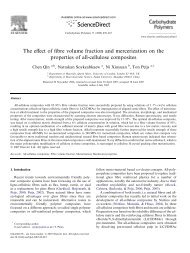A infrared spectroscopic study on the mechanism of temperature ...
A infrared spectroscopic study on the mechanism of temperature ...
A infrared spectroscopic study on the mechanism of temperature ...
You also want an ePaper? Increase the reach of your titles
YUMPU automatically turns print PDFs into web optimized ePapers that Google loves.
A <str<strong>on</strong>g>infrared</str<strong>on</strong>g> <str<strong>on</strong>g>spectroscopic</str<strong>on</strong>g> <str<strong>on</strong>g>study</str<strong>on</strong>g> <strong>on</strong> <strong>the</strong> <strong>mechanism</strong> <strong>of</strong> <strong>temperature</strong>-induced phase<br />
transiti<strong>on</strong> <strong>of</strong> c<strong>on</strong>centrated aqueous soluti<strong>on</strong>s <strong>of</strong> poly(N-isopropylacrylamide)<br />
and N-isopropylpropi<strong>on</strong>amide<br />
Hengjie Lai, Peiyi Wu *<br />
The Key Laboratory <strong>of</strong> Molecular Engineering <strong>of</strong> Polymers, Ministry <strong>of</strong> Educati<strong>on</strong>, Department <strong>of</strong> Macromolecular Science, Laboratory <strong>of</strong> Advanced Materials,<br />
Fudan University, Shanghai 200433, PR China<br />
article info<br />
Article history:<br />
Received 16 November 2009<br />
Received in revised form<br />
12 January 2010<br />
Accepted 17 January 2010<br />
Available <strong>on</strong>line 1 February 2010<br />
Keywords:<br />
Poly(N-isopropylacrylamide)<br />
N-isopropylpropi<strong>on</strong>amide<br />
Perturbati<strong>on</strong> correlati<strong>on</strong> moving window<br />
1. Introducti<strong>on</strong><br />
abstract<br />
Poly(N-isopropylacrylamide) (PNIPAM) is a well-known<br />
<strong>temperature</strong>-sensitive polymer whose aqueous soluti<strong>on</strong>s undergo<br />
coil–globule transiti<strong>on</strong> above its lower critical soluti<strong>on</strong> <strong>temperature</strong><br />
(LCST) [1–3]. Several research groups have investigated <strong>the</strong> <strong>mechanism</strong><br />
<strong>of</strong> this phase separati<strong>on</strong> using various kinds <strong>of</strong> methods,<br />
including high-frequency dielectric relaxati<strong>on</strong> techniques [4,5],<br />
NMR [6–8], differential scanning calorimetry [9–12], IR spectroscopy<br />
[13–18], Raman spectroscopy [19–21] and quantum chemical<br />
calculati<strong>on</strong>s [2,21,22].<br />
Recently, <strong>the</strong>re are two ‘‘c<strong>on</strong>trary’’ viewpoints reported in view<br />
<strong>of</strong> <strong>the</strong> phase behavior <strong>of</strong> PNIPAM (Scheme 1(a)) and its small<br />
molecular model compound, N-isopropylpropi<strong>on</strong>amide (NIPPA)<br />
(Scheme 1(b)). A dielectric relaxati<strong>on</strong> <str<strong>on</strong>g>study</str<strong>on</strong>g> [5] revealed that <strong>the</strong><br />
number <strong>of</strong> water molecules hydrated with NIPPA kept a c<strong>on</strong>stant<br />
value above <strong>the</strong> LCST <strong>of</strong> 32 C, while <strong>the</strong> value for aqueous PNIPAM<br />
soluti<strong>on</strong> changed sharply at <strong>the</strong> LCST. The phase behavior <strong>of</strong> NIPPA<br />
soluti<strong>on</strong> in deuterated water has been investigated by Meersman<br />
et al. [23]. Different features have been illustrated clearly via<br />
<strong>temperature</strong>–compositi<strong>on</strong> phase diagram <strong>of</strong> NIPPA/D2O and<br />
* Corresp<strong>on</strong>ding author.<br />
E-mail address: peiyiwu@fudan.edu.cn (P. Wu).<br />
0032-3861/$ – see fr<strong>on</strong>t matter Ó 2010 Elsevier Ltd. All rights reserved.<br />
doi:10.1016/j.polymer.2010.01.036<br />
Polymer 51 (2010) 1404–1412<br />
C<strong>on</strong>tents lists available at ScienceDirect<br />
Polymer<br />
journal homepage: www.elsevier.com/locate/polymer<br />
FTIR in combinati<strong>on</strong> with perturbati<strong>on</strong> correlati<strong>on</strong> moving window (PCMW) technique was applied to<br />
<str<strong>on</strong>g>study</str<strong>on</strong>g> <strong>the</strong> phase transiti<strong>on</strong> <strong>of</strong> c<strong>on</strong>centrated aqueous soluti<strong>on</strong>s <strong>of</strong> Poly(N-isopropylacrylamide) (PNIPAM)<br />
and its small molecular model compound N-isopropylpropi<strong>on</strong>amide(NIPPA). It was found that lower<br />
critical soluti<strong>on</strong> <strong>temperature</strong> (LSCT) <strong>of</strong> 40% NIPPA/D2O soluti<strong>on</strong> was 39 C which was higher by ca. 8 C<br />
than that <strong>of</strong> PNIPAM, and that NIPPA exhibited much wider <strong>temperature</strong> ranges <strong>of</strong> phase transiti<strong>on</strong> from<br />
30 to 50 C while PNIPAM underwent <strong>the</strong> phase separati<strong>on</strong> in a narrow <strong>temperature</strong> range (29.1–33.1 C).<br />
Moreover, we utilized two-dimensi<strong>on</strong>al correlati<strong>on</strong> <str<strong>on</strong>g>infrared</str<strong>on</strong>g> spectroscopy (2DIR) analysis to reveal that<br />
<strong>the</strong> presence <strong>of</strong> main chains didn’t affect <strong>the</strong> sensitivity and changing sequence <strong>of</strong> different groups, but<br />
did have a str<strong>on</strong>g effect <strong>on</strong> <strong>the</strong> size <strong>of</strong> aggregati<strong>on</strong> and formati<strong>on</strong> <strong>of</strong> hydrogen b<strong>on</strong>ds between carb<strong>on</strong>yl<br />
groups and water molecules. Without <strong>the</strong> interference <strong>of</strong> hydrophobic main chains, <strong>the</strong> carb<strong>on</strong>yls <strong>of</strong><br />
NIPPA (1600 cm 1 ) could interact with more water than those <strong>of</strong> PNIPAM (1627 cm 1 ) below LSCT, which<br />
was <strong>the</strong> reas<strong>on</strong> <strong>of</strong> <strong>the</strong> slower and milder phase transiti<strong>on</strong> taking place in NIPPA system.<br />
Ó 2010 Elsevier Ltd. All rights reserved.<br />
PNIPAM/D2O, and FTIR spectral changes <strong>of</strong> amide groups also<br />
proved that part <strong>of</strong> NIPPA molecules took place liquid–liquid phase<br />
transiti<strong>on</strong> up<strong>on</strong> heating. A linear band shift in amide groups can be<br />
observed at 5 wt% NIPPA/D2O soluti<strong>on</strong> in which no separati<strong>on</strong><br />
occurs. In c<strong>on</strong>trast, at wt ¼ 30%, <strong>the</strong> amide band exhibited a red shift<br />
in an ‘‘S-shaped’’ manner, indicating that deuterated water could get<br />
rid <strong>of</strong> amide groups during liquid–liquid phase transiti<strong>on</strong>. Therefore,<br />
<strong>the</strong> c<strong>on</strong>centrati<strong>on</strong> played an important role in NIPPA system.<br />
Perturbati<strong>on</strong> correlati<strong>on</strong> moving window (PCMW) is a new<br />
analytical tool, whose basic principles base <strong>on</strong> <strong>the</strong> c<strong>on</strong>venti<strong>on</strong>al<br />
moving window proposed by Thomas and Richards<strong>on</strong> [24]. Morita<br />
et al. [25] developed this technique to expand applicability <strong>of</strong><br />
researches by introducing <strong>the</strong> variable perturbati<strong>on</strong> into correlati<strong>on</strong><br />
equati<strong>on</strong>. One <strong>of</strong> <strong>the</strong> advantages <strong>of</strong> this method is that a typical point<br />
(such as LCST) <strong>of</strong> a spectral intensity variati<strong>on</strong> could be visualized in<br />
<strong>the</strong> PCMW correlati<strong>on</strong> spectra. Ano<strong>the</strong>r <strong>on</strong>e is that complicated<br />
spectral intensity variati<strong>on</strong> al<strong>on</strong>g <strong>the</strong> perturbati<strong>on</strong> directi<strong>on</strong> can be<br />
detected. For example, Morita et al. [26] utilized <strong>the</strong> PCMW correlati<strong>on</strong><br />
analysis to find that <strong>the</strong> recrystallizati<strong>on</strong> <strong>of</strong> n<strong>on</strong>-annealed<br />
poly(3-hydroxybutyrate) (PHB) took place between 40 and 110 C<br />
and <strong>the</strong> melting <strong>temperature</strong> could be measured at 190 C by <strong>the</strong><br />
sharp change to <strong>the</strong> broad amorphous C]O stretching absorpti<strong>on</strong>.<br />
Generalized two-dimensi<strong>on</strong>al (2D) correlati<strong>on</strong> spectroscopy is<br />
ano<strong>the</strong>r analytical technique firstly proposed by Noda [27,28],
Scheme 1. Chemical structure <strong>of</strong> PNIPAM (a) and NIPPA (b).<br />
which can be used to investigate <strong>the</strong> spectral intensity fluctuati<strong>on</strong><br />
under a specific perturbati<strong>on</strong> such as <strong>temperature</strong>, time, pH or<br />
c<strong>on</strong>centrati<strong>on</strong> etc. In a word, 2D correlati<strong>on</strong> analysis can not <strong>on</strong>ly<br />
find out complex or overlapped spectral informati<strong>on</strong> and enhance<br />
spectral resoluti<strong>on</strong>, but also it can obtain a series <strong>of</strong> vibrati<strong>on</strong><br />
sequence <strong>of</strong> special groups.<br />
In <strong>the</strong> present <str<strong>on</strong>g>study</str<strong>on</strong>g>, we mainly focus <strong>on</strong> <strong>the</strong> <str<strong>on</strong>g>infrared</str<strong>on</strong>g> spectral<br />
changes <strong>of</strong> C–H and Amide I groups during heating process in 40%<br />
PNIPAM/D2O and 40% NIPPA/D2O soluti<strong>on</strong>. Comparing with PNI-<br />
PAM system, we investigate <strong>the</strong> differences in experimental results<br />
<strong>of</strong> LCST and <strong>temperature</strong> ranges <strong>of</strong> phase separati<strong>on</strong>s, and provide<br />
ano<strong>the</strong>r evidence for <strong>the</strong> phase behavior <strong>of</strong> NIPPA aqueous soluti<strong>on</strong><br />
through PCMW. Moreover, we fur<strong>the</strong>r reveal <strong>the</strong> specific event<br />
sequence <strong>of</strong> different groups in heating process by 2DIR technique,<br />
which may be helpful to understand <strong>the</strong> different phase behaviors<br />
<strong>of</strong> PNIPAM and NIPPA <strong>on</strong> a molecular level.<br />
2. Experimental secti<strong>on</strong><br />
2.1. Material and syn<strong>the</strong>sis<br />
N-isopropylacylamide (NIPAM) m<strong>on</strong>omers were purchased<br />
from Tokyo Kasei Kogyo Co. (Tokyo, Japan) and used with fur<strong>the</strong>r<br />
purificati<strong>on</strong>. Poly(N-isopropylacylamide) (PNIPAM) was syn<strong>the</strong>sized<br />
by free-radical polymerizati<strong>on</strong> in tetrahydr<strong>of</strong>uran (THF) as<br />
solvent. The reacti<strong>on</strong> was initiated by azobis (isobutyr<strong>on</strong>itrile)<br />
(AIBN) and carried out at 70 C for 12 h under nitrogen atmosphere.<br />
After precipitati<strong>on</strong>s, products were dried under vacuum to c<strong>on</strong>stant<br />
weight. The molecular weight <strong>of</strong> PNIPAM, Mw ¼ 2498, and polydispersity<br />
index, Mw/Mn ¼ 1.34, were measured by a Voyager DE-<br />
STR matrix-assisted laser desorpti<strong>on</strong>/i<strong>on</strong>izati<strong>on</strong> time-<strong>of</strong>-flight<br />
(MALDI-TOF MS) mass spectrometer equipped with a 337 nm<br />
nitrogen laser.<br />
N-isopropylpropi<strong>on</strong>amide (NIPPA) was syn<strong>the</strong>sized by <strong>the</strong> wellknown<br />
Schotten–Baumann reacti<strong>on</strong>. Propi<strong>on</strong>yl chloride (0.1 mol)<br />
were added dropwise into isopropyl amine (0.11 mol)/Triethylamine<br />
(0.09 mol)/THF soluti<strong>on</strong> in <strong>the</strong> ice-water bath under<br />
c<strong>on</strong>tinuous stirring. After removal <strong>of</strong> amine hydrochloride by<br />
filtrati<strong>on</strong>, <strong>the</strong> residue was shaken with 2 mol/L aqueous NaHCO3,<br />
and <strong>the</strong>n it were dried with anhydrous sodium sulfate. After<br />
removal <strong>of</strong> sodium sulfate, residual solvent was removed via rotary<br />
evaporati<strong>on</strong>. The product was stored in a dessicator to minimise <strong>the</strong><br />
absorpti<strong>on</strong> <strong>of</strong> water. The chemical structure and purity <strong>of</strong> NIPPA in<br />
deuterated chlor<strong>of</strong>orm was c<strong>on</strong>firmed by 1 H NMR (Varian Mercury<br />
plus 400) (d, ppm, 25 C): 5.28 (s, 1H), 4.09 (m, 1H), 2.16 (q, 2H), 1.16<br />
(m, 9H). The compositi<strong>on</strong> has been determined by element analysis<br />
(ELEMEN TAR VARIO EL3): C, 62.6; H, 11.3; N, 12.15.<br />
2.2. Sample preparati<strong>on</strong><br />
PNIPAM and NIPPA were respectively dissolved in deuterated<br />
water (Cambridge Isotope Laboratories, Inc., D-99.9%) with<br />
H. Lai, P. Wu / Polymer 51 (2010) 1404–1412 1405<br />
a c<strong>on</strong>centrati<strong>on</strong> <strong>of</strong> 40 wt%. The soluti<strong>on</strong> was kept for two days<br />
before experiments in order to ensure <strong>the</strong> complete deuterati<strong>on</strong> <strong>of</strong><br />
all <strong>the</strong> NH-prot<strong>on</strong>s.<br />
2.3. Fourier transform <str<strong>on</strong>g>infrared</str<strong>on</strong>g> spectroscopy<br />
The samples <strong>of</strong> PNIPAM and NIPPA deuterated water soluti<strong>on</strong>s<br />
were respectively placed in <strong>the</strong> middle <strong>of</strong> two CaF2 tablets. The FTIR<br />
spectra were measured <strong>on</strong> a Nicolet Nexus 470 spectrometer<br />
equipped with a DTGS detector. A total <strong>of</strong> 32 scans at a resoluti<strong>on</strong> <strong>of</strong><br />
4 cm 1 were collected. Variable-<strong>temperature</strong> spectra were<br />
c<strong>on</strong>trolled between 22 and 41 C with an increment <strong>of</strong> 1 C for 40%<br />
PNIPAM/D2O soluti<strong>on</strong> as well as between 18.5 and 70.5 C with an<br />
increment <strong>of</strong> 2 C for 40% NIPPA/D2O soluti<strong>on</strong>. The data processing<br />
was performed by <strong>the</strong> s<strong>of</strong>tware <strong>of</strong> OMNIC 8.0.<br />
2.4. Two-dimensi<strong>on</strong>al correlati<strong>on</strong> analysis<br />
Baseline correcti<strong>on</strong> was performed for all spectra in certain<br />
wavenumber ranges before calculati<strong>on</strong> <strong>of</strong> <strong>the</strong> 2D correlati<strong>on</strong>. The<br />
generalized 2D correlati<strong>on</strong> analysis was applied by <strong>the</strong> 2D Shige<br />
ver. 1.3 (Shigeaki Morita, Kwansei-Gakuin University, Japan,<br />
2004–2005) tailored by Shigeaki Morita, and was fur<strong>the</strong>r plotted<br />
by Origin program 8.0 in order to obtain 2D correlati<strong>on</strong> maps<br />
with good quality and clarity. In <strong>the</strong> 2D c<strong>on</strong>tour maps, <strong>the</strong> redcolored<br />
regi<strong>on</strong>s are defined as <strong>the</strong> positive correlati<strong>on</strong> intensities,<br />
while <strong>the</strong> blue-colored <strong>on</strong>es mean <strong>the</strong> negative correlati<strong>on</strong><br />
intensities.<br />
2.5. Perturbati<strong>on</strong> correlati<strong>on</strong> moving window<br />
Perturbati<strong>on</strong> correlati<strong>on</strong> moving window (PCMW) is expressed<br />
as a pair <strong>of</strong> synchr<strong>on</strong>ous and asynchr<strong>on</strong>ous correlati<strong>on</strong> spectra<br />
plotted <strong>on</strong> a plane between a spectral variable axis and a perturbati<strong>on</strong><br />
variable axis. FTIR spectra were carried out with this method<br />
and fur<strong>the</strong>r correlati<strong>on</strong> informati<strong>on</strong> was also calculated by <strong>the</strong><br />
s<strong>of</strong>tware 2D Shige with window size (2m þ 1 ¼ 9). Similarly, <strong>the</strong><br />
c<strong>on</strong>tour maps were plotted by Origin program 8.0 with <strong>the</strong> same<br />
colors defined as <strong>the</strong> same means as 2D correlati<strong>on</strong> analysis.<br />
2.6. Differential scanning calorimetry<br />
DSC measurements <strong>of</strong> <strong>the</strong> 40 wt% PNIPAM/D2O or 40 wt% NIPPA/<br />
D2O soluti<strong>on</strong>s were performed by Mettler-Toledo DSC 1 with<br />
a scanning rate <strong>of</strong> 15 C/min. This was run with <strong>on</strong>e heating scan in<br />
<strong>the</strong> 10 to 100 C <strong>temperature</strong> range.<br />
3. Results and discussi<strong>on</strong><br />
3.1. DSC analysis for NIPPA and PNIPAM systems<br />
Fig. 1 shows <strong>the</strong> DSC <strong>the</strong>rmographs <strong>of</strong> 40 wt% PNIPAM/D2O<br />
soluti<strong>on</strong> (a) and 40 wt% NIPPA/D2O soluti<strong>on</strong> (b). As can be seen in<br />
Fig. 1(a), <strong>the</strong> sharp peak <strong>of</strong> endo<strong>the</strong>rmic transiti<strong>on</strong> is obtained<br />
around 33.5 C for polymer system. Fur<strong>the</strong>rmore, we just find<br />
a small and broad peak in <strong>the</strong> NIPPA system (seen in Fig. 1(b)), and<br />
<strong>the</strong> <strong>temperature</strong> corresp<strong>on</strong>ding to <strong>the</strong> peak value is 37.5 C. From<br />
above comparis<strong>on</strong>, we can find that PNIPAM aqueous soluti<strong>on</strong><br />
undergoes a drastic phase separati<strong>on</strong> because calorimetric<br />
enthalpy <strong>of</strong> PNIPAM is much larger than that <strong>of</strong> NIPPA. In additi<strong>on</strong>,<br />
it is notable that <strong>temperature</strong> range <strong>of</strong> phase transiti<strong>on</strong> is from<br />
29 Cto40 C in PNIPAM system, while <strong>the</strong> small and asymmetric<br />
peak actually ranges from 30 to 60 C, suggesting that cooperativity<br />
<strong>of</strong> <strong>the</strong> dehydrati<strong>on</strong> <strong>of</strong> NIPPA is low and that <strong>the</strong> phase transiti<strong>on</strong><br />
takes place in a much slower process up<strong>on</strong> heating. In order to
1406<br />
Fig. 1. Heating DSC <strong>the</strong>rmograms for aqueous soluti<strong>on</strong> <strong>of</strong> PNIPAM (a) and NIPPA (b). Schematic diagram <strong>of</strong> intensities change <strong>of</strong> hydrated methyl and less hydrated methyl in NIPPA<br />
system (c) and PNIPAM system (d). Spectral variati<strong>on</strong> in <strong>the</strong> methyl band <strong>of</strong> PNIPAM (e) and NIPPA (f) as a functi<strong>on</strong> <strong>of</strong> <strong>temperature</strong>. Soluti<strong>on</strong> c<strong>on</strong>centrati<strong>on</strong>s <strong>of</strong> two samples: 40 wt%<br />
for PNIPAM and 40 wt% for NIPPA. * - emphasizes that <strong>the</strong> c<strong>on</strong>centrati<strong>on</strong>s are same in two different soluti<strong>on</strong>s.<br />
c<strong>on</strong>firm and explain <strong>the</strong> DSC results, we fur<strong>the</strong>r <str<strong>on</strong>g>study</str<strong>on</strong>g> <strong>the</strong>se<br />
molecular <strong>mechanism</strong>s <strong>of</strong> phase transiti<strong>on</strong>s by IR, PCMW and 2DIR<br />
analysis.<br />
3.2. IR & PCMW analysis for PNIPAM systems<br />
The <strong>temperature</strong>-induced spectral variati<strong>on</strong>s in <strong>the</strong> C–H regi<strong>on</strong><br />
<strong>of</strong> PNIPAM aqueous soluti<strong>on</strong> have been investigated by several<br />
independent research groups. According to literature, <strong>the</strong> number<br />
<strong>of</strong> hydrated –CH3 groups would decrease sharply above LCST in <strong>the</strong><br />
<strong>temperature</strong>-elevati<strong>on</strong> process because <strong>the</strong> hydrati<strong>on</strong> interacti<strong>on</strong><br />
had been weakened.<br />
Fig. 2 shows <strong>the</strong> <strong>temperature</strong> dependence <strong>of</strong> <strong>the</strong> absorpti<strong>on</strong><br />
band <strong>of</strong> <strong>the</strong> C–H regi<strong>on</strong>. This regi<strong>on</strong> is mainly composed <strong>of</strong> three<br />
distinct peaks [29]: nas(CH3) <strong>of</strong> <strong>the</strong> side chains <strong>of</strong> PNIPAM at ca.<br />
2981 cm 1 , nas(CH2) <strong>of</strong> <strong>the</strong> main chains at ca. 2939 cm 1 and<br />
ns(CH3) <strong>of</strong> <strong>the</strong> side chains <strong>of</strong> PNIPAM at ca. 2881 cm 1 . Several<br />
spectral changes can be easily observed in Fig. 2, <strong>the</strong> bands <strong>of</strong><br />
nas(CH3), nas(CH2) and ns(CH3) all shift to <strong>the</strong> lower wavenumber<br />
up<strong>on</strong> heating. What’s more, <strong>the</strong> most significant red shift happens<br />
when <strong>the</strong> <strong>temperature</strong> reaches above LCST (around 32 C). Therefore,<br />
it truly reveals dehydrati<strong>on</strong> <strong>of</strong> <strong>the</strong> CH3 and CH2 groups is also<br />
a sign for phase transiti<strong>on</strong> just as hydrogen b<strong>on</strong>ds <strong>of</strong> C]O/D–O–D<br />
are partially destroyed during <strong>the</strong> coil-to-globule transiti<strong>on</strong>.<br />
H. Lai, P. Wu / Polymer 51 (2010) 1404–1412<br />
As is menti<strong>on</strong>ed before, perturbati<strong>on</strong> correlati<strong>on</strong> moving<br />
window is a powerful method to determine <strong>the</strong> transiti<strong>on</strong> point. The<br />
PCMW spectra calculated from <strong>the</strong> <strong>temperature</strong>-dependent IR<br />
spectra <strong>of</strong> <strong>the</strong> PNIPAM 40 wt% D2O soluti<strong>on</strong> in <strong>the</strong> 3060–2850 cm 1<br />
Fig. 2. FTIR spectral variati<strong>on</strong>s in <strong>the</strong> CH regi<strong>on</strong> <strong>of</strong> PNIPAM 40 wt% D2O soluti<strong>on</strong> as<br />
a functi<strong>on</strong> <strong>of</strong> <strong>temperature</strong>. The <strong>temperature</strong> was varied between 22 and 41 C with an<br />
interval <strong>of</strong> 1 C.
Fig. 3. 2D synchr<strong>on</strong>ous (a) and asynchr<strong>on</strong>ous (b) spectra <strong>of</strong> PCMW performed in <strong>the</strong> <strong>temperature</strong> range 22–41 C in <strong>the</strong> regi<strong>on</strong>s (3060–2850 cm 1 ) <strong>of</strong> PNIPAM 40 wt% D2O soluti<strong>on</strong>.<br />
Red colors are defined as positive intensities, while blue colors as negative <strong>on</strong>es. (For interpretati<strong>on</strong> <strong>of</strong> <strong>the</strong> references to colour in this figure legend, <strong>the</strong> reader is referred to <strong>the</strong> web<br />
versi<strong>on</strong> <strong>of</strong> this article.)<br />
regi<strong>on</strong> are shown in Fig. 3. Both synchr<strong>on</strong>ous and asynchr<strong>on</strong>ous<br />
PCMW spectra are composed <strong>of</strong> a wavenumber axis and a <strong>temperature</strong><br />
axis. In <strong>the</strong> synchr<strong>on</strong>ous spectrum (Fig. 3(a)), it is notable that<br />
<strong>the</strong> band <strong>of</strong> nas(CH3) is divided into two peaks: <strong>the</strong> red <strong>on</strong>e is<br />
centered at about 2970 cm 1 which can be attributed to <strong>the</strong> less<br />
hydrated methyl groups, and <strong>the</strong> blue <strong>on</strong>e is centered at 2990 cm 1<br />
which can be attributed to <strong>the</strong> hydrated methyl groups. More<br />
important, LCST (31.2 C) and <strong>the</strong> <strong>temperature</strong> range <strong>of</strong> phase<br />
transiti<strong>on</strong> (29.1–33.1 C) <strong>of</strong> PNIPAM aqueous soluti<strong>on</strong> could be easily<br />
found from <strong>the</strong> synchr<strong>on</strong>ous spectrum (Fig. 3(a)) and asynchr<strong>on</strong>ous<br />
spectrum (Fig. 3(b)), respectively. These results agree well with <strong>the</strong><br />
c<strong>on</strong>clusi<strong>on</strong> o<strong>the</strong>r researchers have reported [30] and our DSC result.<br />
According to <strong>the</strong> rule <strong>of</strong> PCMW (in <strong>the</strong> case <strong>of</strong> linear increment<br />
perturbati<strong>on</strong>) summarized in Table 1 by Morita et al. [25], <strong>the</strong><br />
synchr<strong>on</strong>ous PCMW correlati<strong>on</strong> spectrum represents a direct<br />
correlati<strong>on</strong> between <strong>the</strong> spectral intensity change and <strong>the</strong> given<br />
perturbati<strong>on</strong> change, while <strong>the</strong> asynchr<strong>on</strong>ous <strong>on</strong>e is a correlati<strong>on</strong><br />
between <strong>the</strong> spectral intensity change and a discrete Hilbert<br />
transform <strong>of</strong> <strong>the</strong> perturbati<strong>on</strong> change. Therefore, positive regi<strong>on</strong><br />
(red-colored regi<strong>on</strong>) in synchr<strong>on</strong>ous correlati<strong>on</strong> represents spectral<br />
intensity increment, while negative <strong>on</strong>e (blue-colored regi<strong>on</strong>)<br />
represents decrement. And positive asynchr<strong>on</strong>ous correlati<strong>on</strong><br />
means a c<strong>on</strong>vex spectral intensity variati<strong>on</strong> while negative <strong>on</strong>e<br />
Table 1<br />
Rules <strong>of</strong> PCMW correlati<strong>on</strong> spectroscopy [25].<br />
Synchr<strong>on</strong>ous Asynchr<strong>on</strong>ous Spectral change<br />
þ þ C<strong>on</strong>vex increment<br />
þ 0 Linear increment<br />
þ C<strong>on</strong>cave increment<br />
0 þ C<strong>on</strong>vex top<br />
0 0 C<strong>on</strong>stant<br />
0 C<strong>on</strong>cave bottom<br />
þ C<strong>on</strong>vex decrement<br />
0 Linear decrement<br />
C<strong>on</strong>cave decrement<br />
H. Lai, P. Wu / Polymer 51 (2010) 1404–1412 1407<br />
means a c<strong>on</strong>cave variati<strong>on</strong>. Besides, zero regi<strong>on</strong> (white-colored<br />
regi<strong>on</strong>) means linear change in both two PCMW spectra.<br />
So negative regi<strong>on</strong> at 2990 cm 1 in Fig. 3(a) implies that<br />
deuterated water molecules leave from methyl groups and <strong>the</strong><br />
number <strong>of</strong> hydrated methyl groups is decreasing. As a result, less<br />
hydrated methyl groups (2970 cm 1 ) are becoming more and more.<br />
Hence, we can figure out <strong>the</strong> dehydrati<strong>on</strong> mainly happens to<br />
methyl groups as <strong>the</strong> PNIPAM soluti<strong>on</strong> undergoes phase separati<strong>on</strong><br />
at 31.2 C up<strong>on</strong> heating.<br />
Moreover, let us c<strong>on</strong>sider <strong>the</strong> correlati<strong>on</strong> peaks observed in both<br />
<strong>the</strong> synchr<strong>on</strong>ous and asynchr<strong>on</strong>ous PCMW spectra. The variati<strong>on</strong> in<br />
hydrated methyl band below LCST is expressed as synchr<strong>on</strong>ous<br />
spectra (2990 cm 1 , 29.1 C) < 0 and asynchr<strong>on</strong>ous spectra<br />
(2990 cm 1 , 29.1 C) > 0. These results suggest that <strong>the</strong> spectral<br />
intensity change should be a c<strong>on</strong>vex decrement according to <strong>the</strong><br />
rule <strong>of</strong> PCMW (seen in Table 1). On <strong>the</strong> o<strong>the</strong>r hand, above <strong>the</strong><br />
characteristic <strong>temperature</strong> <strong>of</strong> LCST at hydrated methyl band,<br />
synchr<strong>on</strong>ous spectra (2990 cm 1 , 33.1 C) < 0 and asynchr<strong>on</strong>ous<br />
spectra (2990 cm 1 , 33.1 C) < 0. It implies that spectral intensity<br />
change should be a c<strong>on</strong>cave decrement. Around LCST (31.2 C), we<br />
can find synchr<strong>on</strong>ous spectra (2990 cm 1 ,31.2 C) < 0 and asynchr<strong>on</strong>ous<br />
spectra (2990 cm 1 ,31.2 C) ¼ 0. These results dem<strong>on</strong>strate<br />
that <strong>the</strong> spectral intensity exhibits a linear decrement.<br />
Therefore, <strong>the</strong> integral intensities <strong>of</strong> all three regi<strong>on</strong>s appear to<br />
show an interesting imaged‘‘anti-S-shape’’ decrement.<br />
For <strong>the</strong> less hydrated methyl groups that are centered at about<br />
2970 cm 1 , <strong>the</strong>re are also three types <strong>of</strong> intensity change: Below<br />
LCST, synchr<strong>on</strong>ous spectra (2970 cm 1 , 29.1 C) > 0 and asynchr<strong>on</strong>ous<br />
spectra (2970 cm 1 , 29.1 C) < 0; Above LCST, synchr<strong>on</strong>ous<br />
spectra (2970 cm 1 , 33.1 C) > 0 and asynchr<strong>on</strong>ous spectra<br />
(2970 cm 1 , 33.1 C) > 0; Around LCST, synchr<strong>on</strong>ous spectra<br />
(2970 cm 1 ,31.2 C) > 0 and asynchr<strong>on</strong>ous spectra (2970 cm 1 ,<br />
31.2 C) ¼ 0. They are described as a c<strong>on</strong>cave increment, a c<strong>on</strong>vex<br />
increment and a linear increment, respectively. So this process can<br />
be depicted as ‘‘S-shape’’ increment which is opposite to <strong>the</strong> change<br />
<strong>of</strong> hydrated methyl groups completely (seen in Fig. 1(c)).<br />
In a previous work, we presented that <strong>the</strong> dehydrati<strong>on</strong> process<br />
could be divided into two steps [14]. Methyl groups hydrated with<br />
many water molecules first changed to <strong>the</strong> less hydrated methyl<br />
groups, <strong>the</strong>n less hydrated methyl groups would fur<strong>the</strong>r dehydrated<br />
with a sec<strong>on</strong>d step. In this paper, we find, by means <strong>of</strong> PCMW<br />
analysis, ano<strong>the</strong>r important phenomen<strong>on</strong> that less hydrated methyl<br />
groups exists a rapid change between 29.1 and 33.1 C during<br />
heating process. So according to dehydrated formati<strong>on</strong> rate, <strong>the</strong><br />
intensity change <strong>of</strong> hydrated methyl undergoes three-step process:<br />
Firstly, many water molecules interact with methyl groups, and <strong>on</strong>ly<br />
a small fracti<strong>on</strong> <strong>of</strong> water gets rid <strong>of</strong> methyl groups before 29.1 C;
1408<br />
Fig. 4. FTIR spectral variati<strong>on</strong>s in <strong>the</strong> CH regi<strong>on</strong> <strong>of</strong> NIPPA 40 wt% D2O soluti<strong>on</strong> as<br />
a functi<strong>on</strong> <strong>of</strong> <strong>temperature</strong>. The <strong>temperature</strong> was varied between 18.5 and 70.5 C with<br />
an interval <strong>of</strong> 2 C.<br />
Sec<strong>on</strong>dly, a lot <strong>of</strong> water molecules rapidly escape from methyl<br />
groups so that <strong>the</strong> intensity <strong>of</strong> hydrated methyl groups exhibits<br />
sharp decrement between 29.1 and 33.1 C; Thirdly, <strong>the</strong> dehydrated<br />
process <strong>of</strong> methyl groups keep stable gradually after 33.1 C.<br />
Am<strong>on</strong>g <strong>the</strong>m, <strong>the</strong> sec<strong>on</strong>d significant step represents <strong>the</strong> core <strong>of</strong><br />
‘‘S-shape’’ or ‘‘anti-S-shape’’ intensity change, which is also<br />
a typical sign <strong>of</strong> phase transiti<strong>on</strong>. Therefore, it indicates that PCMW<br />
is really a useful method to find <strong>the</strong> transiti<strong>on</strong> points and greatly<br />
simplify <strong>the</strong> investigati<strong>on</strong> <strong>of</strong> complicated spectral variati<strong>on</strong>s.<br />
3.3. IR & PCMW analysis for NIPPA systems<br />
In Fig. 4, <strong>the</strong> change <strong>of</strong> <strong>the</strong> absorpti<strong>on</strong> band <strong>of</strong> –CH3 groups and<br />
–CH2– groups in 40 wt% NIPPA/D2O soluti<strong>on</strong> have been m<strong>on</strong>itored<br />
from 18.5 to 70.5 C. Similarly, this regi<strong>on</strong> is also mainly composed<br />
<strong>of</strong> three distinct peaks: nas(CH3) at about 2979 cm 1 , nas(CH2) at<br />
about 2929 cm 1 and ns(CH3) at about 2871 cm 1 . From c<strong>on</strong>venti<strong>on</strong>al<br />
IR spectra, we can find all peaks shift to <strong>the</strong> low wavenumber,<br />
especially <strong>the</strong> red shift <strong>of</strong> nas(CH3) during heating process. And it is<br />
noteworthy that rapid shift <strong>of</strong> NIPPA aqueous soluti<strong>on</strong> is not as<br />
significant as <strong>on</strong>e <strong>of</strong> PNIPAM aqueous soluti<strong>on</strong>.<br />
Fig. 5 is <strong>the</strong> 2D synchr<strong>on</strong>ous and asynchr<strong>on</strong>ous spectra <strong>of</strong> PCMW<br />
in NIPPA system. Combining with synchr<strong>on</strong>ous and asynchr<strong>on</strong>ous<br />
spectral informati<strong>on</strong> <strong>of</strong> nas(CH3) regi<strong>on</strong>, we can read <strong>the</strong> transiti<strong>on</strong><br />
H. Lai, P. Wu / Polymer 51 (2010) 1404–1412<br />
Table 2<br />
Different features <strong>of</strong> phase behaviors in PNIPAM and NIPPA.<br />
Systems LSCT/ C Temperature ranges<br />
<strong>of</strong> phase transiti<strong>on</strong>/ C<br />
State <strong>of</strong> phase<br />
transiti<strong>on</strong><br />
40% PNIPAM/D2O 31.2 29.1–33.1 Liquid / solid<br />
40% NIPPA/D2O 39 30–50 Liquid / liquid<br />
point is at about 39 C, and that synchr<strong>on</strong>ous spectra (2987 cm 1 ,<br />
30.0 C) < 0, asynchr<strong>on</strong>ous spectra (2987 cm 1 , 30.0 C) > 0 below<br />
<strong>the</strong> transiti<strong>on</strong> point, and that synchr<strong>on</strong>ous spectra (2987 cm 1 ,<br />
50.0 C) < 0, asynchr<strong>on</strong>ous spectra (2987 cm 1 , 50.0 C) < 0 above<br />
<strong>the</strong> transiti<strong>on</strong> point, and that synchr<strong>on</strong>ous spectra (2987 cm 1 ,<br />
39 C) < 0, asynchr<strong>on</strong>ous spectra (2987 cm 1 ,39 C) ¼ 0 around <strong>the</strong><br />
transiti<strong>on</strong> point. It indicated that intensities change <strong>of</strong> <strong>the</strong> band at<br />
2987 cm 1 assigned to hydrated methyl groups can be described as<br />
‘‘anti-S-shape’’ decrement in accordance with <strong>the</strong> rules <strong>of</strong> PCMW.<br />
Additi<strong>on</strong>ally, ano<strong>the</strong>r absorpti<strong>on</strong> bands centered at ca. 2966 cm 1<br />
can be attributed to <strong>the</strong> vibrati<strong>on</strong> <strong>of</strong> less hydrated methyl groups <strong>of</strong><br />
NIPPA molecules. In this regi<strong>on</strong>, <strong>the</strong>re are also three steps <strong>of</strong><br />
intensities change: synchr<strong>on</strong>ous spectra (2966 cm 1 , 30.0 C) > 0,<br />
asynchr<strong>on</strong>ous spectra (2966 cm 1 , 30.0 C) < 0 below <strong>the</strong> transiti<strong>on</strong><br />
point, and synchr<strong>on</strong>ous spectra (2966 cm 1 , 50.0 C) > 0, asynchr<strong>on</strong>ous<br />
spectra (2966 cm 1 , 50.0 C) > 0 above <strong>the</strong> transiti<strong>on</strong><br />
point, and synchr<strong>on</strong>ous spectra (2966 cm 1 ,39 C) > 0, asynchr<strong>on</strong>ous<br />
spectra (2966 cm 1 ,39 C) ¼ 0 around <strong>the</strong> transiti<strong>on</strong> point.<br />
This result shows that <strong>the</strong> intensities change <strong>of</strong> less hydrated<br />
methyl are followed by <strong>the</strong> mode <strong>of</strong> ‘‘S-shape’’ increment which<br />
depicted in Fig. 1(c and f).<br />
Comparing with <strong>the</strong> spectral c<strong>on</strong>clusi<strong>on</strong> <strong>of</strong> phase transiti<strong>on</strong> in<br />
PNIPAM/D2O soluti<strong>on</strong>, we can find several similar points. Firstly,<br />
methyl groups are divided into two different c<strong>on</strong>formati<strong>on</strong>s<br />
including hydrated methyl and less hydrated methyl in both<br />
systems. It is well known that dehydrati<strong>on</strong> processes can both take<br />
place during heating in PNIPAM/D2O soluti<strong>on</strong> and NIPPA/D2O<br />
soluti<strong>on</strong>. Sec<strong>on</strong>dly, <strong>the</strong> whole intensities change <strong>of</strong> methyl groups is<br />
not linear but ‘‘anti-S-shape’’ or ‘‘S-shape’’, which is a striking<br />
feature to manifest some kind <strong>of</strong> <strong>temperature</strong>-induce phase transiti<strong>on</strong><br />
exists in two systems.<br />
Except for <strong>the</strong>se two similar results, <strong>the</strong>re are some distinct<br />
features listed in Table 2. Most <strong>of</strong> all, <strong>the</strong> former phase transiti<strong>on</strong> is<br />
<strong>the</strong> c<strong>on</strong>formati<strong>on</strong> change <strong>of</strong> liquid and solid phases, while <strong>the</strong> o<strong>the</strong>r<br />
<strong>on</strong>e is called liquid–liquid separati<strong>on</strong>. Sec<strong>on</strong>dly, <strong>the</strong> rapid change<br />
takes place between 30 and 50 C in NIPPA/D2O soluti<strong>on</strong> in<br />
comparis<strong>on</strong> with <strong>the</strong> PNIPAM system which have narrow <strong>temperature</strong><br />
range (from 29.1 to 33.1 C) when <strong>the</strong> rapid change happens.<br />
Fig. 5. 2D synchr<strong>on</strong>ous (a) and asynchr<strong>on</strong>ous (b) spectra <strong>of</strong> PCMW performed in <strong>the</strong> <strong>temperature</strong> range 18.5–70.5 C in <strong>the</strong> regi<strong>on</strong>s (3030–2850 cm 1 ) <strong>of</strong> NIPPA 40 wt% D2O<br />
soluti<strong>on</strong>. Red colors are defined as positive intensities, while blue colors as negative <strong>on</strong>es. (For interpretati<strong>on</strong> <strong>of</strong> <strong>the</strong> references to colour in this figure legend, <strong>the</strong> reader is referred to<br />
<strong>the</strong> web versi<strong>on</strong> <strong>of</strong> this article.)
Table 3<br />
Band assignments <strong>of</strong> NIPPA and PNIPAM aqueous soluti<strong>on</strong> according to c<strong>on</strong>venti<strong>on</strong>al<br />
IR as well as 2DIR.<br />
PNIPAM NIPPA<br />
Wavenumber/cm 1 Assignment Wavenumber/cm 1 Assignment<br />
2989 Hydrated<br />
nas(CH3)<br />
2987 Hydrated nas(CH3)<br />
2969 Less hydrated<br />
nas(CH3)<br />
2966 Less hydrated nas(CH3)<br />
2927 nas(CH2) 2929 nas(CH2)<br />
2871 ns(CH3) 2873 ns(CH3)<br />
1652 C]O/D–N 1652 C]O/D–N<br />
1627 C]O/D–O–D 1600 C]O/(D–O–D)n<br />
(n > 1)<br />
So in NIPPA system it would take l<strong>on</strong>g time to complete dehydrati<strong>on</strong><br />
process so that phase separati<strong>on</strong> is very mild, as indicated by<br />
our DSC measurement. In c<strong>on</strong>trast, PNIPAM system takes less time<br />
completing and reaching stable level. Besides, two systems have<br />
different transiti<strong>on</strong> points, and transiti<strong>on</strong> <strong>temperature</strong> <strong>of</strong> 40 wt%<br />
NIPPA/D2O soluti<strong>on</strong> is higher than that <strong>of</strong> 40 wt% PNIPAM/D2O<br />
soluti<strong>on</strong>. So <strong>the</strong>se results indicate that <strong>the</strong> reas<strong>on</strong> <strong>of</strong> different<br />
features is induced by a great number <strong>of</strong> hydrophobic main chains<br />
in PNIPAM hindering from c<strong>on</strong>tact between water and amide<br />
groups, which aggravates occurrence <strong>of</strong> <strong>the</strong> phase separati<strong>on</strong>.<br />
3.4. 2DIR analysis for NIPPA systems<br />
Based <strong>on</strong> above analysis and results, <strong>the</strong> different features <strong>of</strong><br />
phase separati<strong>on</strong> in NIPPA/D2O and PNIPAM/D2O soluti<strong>on</strong> have<br />
been discussed. To fur<strong>the</strong>r compare <strong>the</strong>se processes, we employ<br />
two-dimensi<strong>on</strong>al correlati<strong>on</strong> analysis to explore <strong>the</strong> microdynamics<br />
<strong>mechanism</strong> <strong>of</strong> <strong>the</strong> phase transiti<strong>on</strong>s.<br />
In 2D correlati<strong>on</strong> analysis, two types <strong>of</strong> correlati<strong>on</strong> maps<br />
(synchr<strong>on</strong>ous and asynchr<strong>on</strong>ous spectra) are obtained from a series<br />
<strong>of</strong> dynamic spectra, which are both characterized by two independent<br />
wavenumber axes (n1, n2) and a correlati<strong>on</strong> intensity axis.<br />
In this paper, <strong>the</strong> red-colored and blue-colored areas in <strong>the</strong> 2DIR<br />
correlati<strong>on</strong> c<strong>on</strong>tour maps represent positive and negative peaks,<br />
respectively. Synchr<strong>on</strong>ous spectra (marked it as F) is symmetric<br />
with respect to <strong>the</strong> diag<strong>on</strong>al line in <strong>the</strong> correlati<strong>on</strong> map, while <strong>the</strong><br />
asynchr<strong>on</strong>ous spectra (marked it as J) is asymmetric with respect<br />
to <strong>the</strong> diag<strong>on</strong>al line in <strong>the</strong> correlati<strong>on</strong> map Hence, combined with<br />
synchr<strong>on</strong>ous and asynchr<strong>on</strong>ous spectra, some useful informati<strong>on</strong><br />
about <strong>the</strong> temporal sequence <strong>of</strong> events can be obtained according<br />
to Noda’s rule [27,28] – that is, when F(n1, n2) > 0, J(n1, n2) > 0or<br />
H. Lai, P. Wu / Polymer 51 (2010) 1404–1412 1409<br />
F(n1, n2) < 0, J(n1, n2) < 0, band n1 will vary prior to band n2.IfF(n1,<br />
n2) > 0, J(n1, n2) < 0orF(n1, n2) < 0, J(n1, n2) > 0, band n1 will vary<br />
after n2 under <strong>the</strong> envir<strong>on</strong>mental perturbati<strong>on</strong>.<br />
For <strong>the</strong> c<strong>on</strong>venience <strong>of</strong> discussi<strong>on</strong>, detailed band assignments in<br />
–CH and C]O regi<strong>on</strong>s according to c<strong>on</strong>venti<strong>on</strong>al IR as well as 2DIR<br />
have been listed in Table 3. The synchr<strong>on</strong>ous and asynchr<strong>on</strong>ous<br />
maps for <strong>the</strong> heating process <strong>of</strong> <strong>the</strong> 40 wt% NIPPA/D2O soluti<strong>on</strong> in<br />
<strong>the</strong> 3060–2850 cm 1 regi<strong>on</strong> are shown in Fig. 6. In <strong>the</strong> synchr<strong>on</strong>ous<br />
map (Fig. 6(a)), two str<strong>on</strong>g autopeaks develop at 2987, 2966, 2929<br />
and 2873 cm 1 . The first two autopeaks can been seen directly in<br />
Fig. 6(a), which points out <strong>the</strong> significant change <strong>of</strong> <strong>the</strong>se two<br />
peaks as <strong>temperature</strong> rises, but <strong>the</strong> last two autopeaks are <strong>on</strong>ly<br />
detected from <strong>the</strong> slice spectra at <strong>the</strong> diag<strong>on</strong>al line because <strong>the</strong><br />
intensities change is very weak in <strong>the</strong>se regi<strong>on</strong>s. Besides, three<br />
negative crosspeaks and two positive crosspeaks can be observed<br />
in <strong>of</strong>f-diag<strong>on</strong>al regi<strong>on</strong>. Those negative crosspeaks centered at<br />
(2987, 2966); (2987, 2929); (2987, 2873) cm 1 indicate that<br />
intensity variati<strong>on</strong>s <strong>of</strong> <strong>the</strong> above 2987 and 2966, 2929, 2873 cm 1<br />
are taking place in <strong>the</strong> opposite directi<strong>on</strong>. And ano<strong>the</strong>r two positive<br />
crosspeaks ((2966, 2929); (2966, 2873) cm 1 ) show intensity<br />
variati<strong>on</strong>s <strong>of</strong> 2966, 2929 and 2873 cm 1 bands are all taking place<br />
in <strong>the</strong> same directi<strong>on</strong>.<br />
On <strong>the</strong> o<strong>the</strong>r hand, <strong>the</strong> asynchr<strong>on</strong>ous 2DIR correlati<strong>on</strong> spectra<br />
are shown in Fig. 6(b). Based <strong>on</strong> <strong>the</strong> rule put forward by Noda, <strong>the</strong><br />
symbols <strong>of</strong> (2987, 2966); (2987, 2929); (2987, 2873) cm 1 are both<br />
negative in <strong>the</strong> synchr<strong>on</strong>ous and asynchr<strong>on</strong>ous maps. This reveals<br />
that <strong>the</strong> intensity <strong>of</strong> 2987 cm 1 band varies prior to those <strong>of</strong> 2966,<br />
2929 and 2873 cm 1 bands when <strong>temperature</strong> is heating. O<strong>the</strong>rwise,<br />
<strong>the</strong> symbols <strong>of</strong> (2966, 2929); (2966, 2873) cm 1 are both<br />
positive in synchr<strong>on</strong>ous and asynchr<strong>on</strong>ous maps, which express<br />
<strong>the</strong> intensity <strong>of</strong> 2966 cm 1 band varies prior to those <strong>of</strong> 2929 and<br />
2873 cm 1 bands under <strong>temperature</strong>-induced perturbati<strong>on</strong>. So we<br />
can finally c<strong>on</strong>clude changing sequence <strong>of</strong> four bands depicted as<br />
2987 > 2966 > 2929, 2873 cm 1 (<strong>the</strong> symbol <strong>of</strong> ‘‘>’’ means change<br />
prior to).<br />
In view <strong>of</strong> this sequence, <strong>the</strong> 2987 cm 1 peak <strong>of</strong> nas(CH3) surrounded<br />
by many deuterated water molecules first decrease, and<br />
<strong>the</strong>n becomes <strong>the</strong> less hydrated nas(CH3) (2966 cm 1 ). Those<br />
methyl groups rapidly give up large numbers <strong>of</strong> D2O molecules as<br />
<strong>temperature</strong> rises to near LSCT so that <strong>the</strong> intensities <strong>of</strong> less<br />
hydrated nas(CH3) increase quickly.<br />
Except for <strong>the</strong> above discussi<strong>on</strong> <strong>on</strong> C–H regi<strong>on</strong>, we also pay<br />
attenti<strong>on</strong> to Amide I regi<strong>on</strong> which is sensitive to c<strong>on</strong>formati<strong>on</strong> and<br />
sec<strong>on</strong>dary structures [31]. The synchr<strong>on</strong>ous and asynchr<strong>on</strong>ous<br />
spectra in amide I regi<strong>on</strong> are shown in Fig. 7. In <strong>the</strong> synchr<strong>on</strong>ous<br />
spectrum (Fig. 7(a)), two str<strong>on</strong>g autopeaks at 1652 and 1600 cm 1 ,<br />
Fig. 6. The synchr<strong>on</strong>ous (a) and asynchr<strong>on</strong>ous (b) maps <strong>of</strong> <strong>the</strong> NIPPA 40 wt% D2O soluti<strong>on</strong> in <strong>the</strong> regi<strong>on</strong> <strong>of</strong> 3030–2850 cm 1 representing <strong>the</strong> heating process.
1410<br />
Fig. 7. The synchr<strong>on</strong>ous (a) and asynchr<strong>on</strong>ous (b) maps <strong>of</strong> <strong>the</strong> NIPPA 40 wt% D2O soluti<strong>on</strong> in <strong>the</strong> regi<strong>on</strong> <strong>of</strong> 1680–1570 cm 1 representing <strong>the</strong> heating process.<br />
and a negative crosspeak at (1652,1600) cm 1 can be seen obviously.<br />
The two autopeaks are respectively attributed to <strong>the</strong> C]O/D–N<br />
and C]O/D–O–D hydrogen b<strong>on</strong>ds <strong>of</strong> carb<strong>on</strong>yl stretching vibrati<strong>on</strong>.<br />
It is noticeable that <strong>the</strong> band <strong>of</strong> C]O/D–O–D (1600 cm 1 ) in NIPPA<br />
system is 27 cm 1 lower than compared to that <strong>of</strong> PNIPAM<br />
(1627 cm 1 ), which reveals that strength <strong>of</strong> <strong>the</strong> b<strong>on</strong>d between C and<br />
O atoms is weakened and it can be characterized by magnitude <strong>of</strong><br />
force c<strong>on</strong>stant (k) k(C]O in NIPPA) ¼ 1035.0 N/m; k(C]O in<br />
PNIPAM) ¼ 1070.2 N/m.<br />
wavenumber cm 1 $hðJsÞ$cðm=sÞ$100ðcm=mÞ<br />
¼ h$ðk=mÞ 1=2 =2p<br />
h: Planck’s c<strong>on</strong>stant, c: <strong>the</strong> velocity <strong>of</strong> light in vacuum, k: <strong>the</strong> force<br />
c<strong>on</strong>stant (N/m), m: mcmo/(mc þ mo), where mc and mo are masses<br />
(kg) <strong>of</strong> <strong>the</strong> two nuclei.<br />
The more D atoms <strong>of</strong> D2O share with <strong>the</strong> l<strong>on</strong>e pair electr<strong>on</strong>s <strong>of</strong> O<br />
atoms in carb<strong>on</strong>yl, <strong>the</strong> strength <strong>of</strong> carb<strong>on</strong>yl band becomes weaker.<br />
Therefore, we c<strong>on</strong>sider that carb<strong>on</strong>yls without hydrophobic polymer<br />
chains should be free to interact with more water molecules<br />
below LSCT and this carb<strong>on</strong>yl <strong>of</strong> multiple hydrogen b<strong>on</strong>ds could be<br />
re-depicted as C]O/(D–O–D)n (n > 1) [5,32] (it is hard to<br />
determine <strong>the</strong> accurate number <strong>of</strong> water molecules H-b<strong>on</strong>ding<br />
with carb<strong>on</strong>yl, so we take ‘n’ as subscript). Besides, <strong>the</strong> negative<br />
crosspeak (1652, 1600) cm 1 indicates that <strong>the</strong> band <strong>of</strong> C]O/(D–<br />
O–D)n is increasing while <strong>the</strong> band <strong>of</strong> C]O/D–N is decreasing<br />
during heating according to Noda’s rule. Fur<strong>the</strong>rmore, because<br />
F(1652, 1600) cm 1 is negative and J(1652, 1600) cm 1 is<br />
H. Lai, P. Wu / Polymer 51 (2010) 1404–1412<br />
positive, we can infer that <strong>the</strong> change <strong>of</strong> <strong>the</strong> C]O/(D–O–D)n is<br />
prior to that <strong>of</strong> C]O/D–N when <strong>temperature</strong> rises. It means <strong>the</strong><br />
hydrogen b<strong>on</strong>ds <strong>of</strong> C]O/(D–O–D)n firstly c<strong>on</strong>sume and <strong>the</strong>n <strong>the</strong><br />
new hydrogen b<strong>on</strong>ds <strong>of</strong> C]O/D–N form. Meanwhile, it will take<br />
l<strong>on</strong>ger time to complete <strong>the</strong> dissociati<strong>on</strong> <strong>of</strong> C]O/(D–O–D)n and<br />
hydrogen b<strong>on</strong>ds bridges, because carb<strong>on</strong>yls <strong>of</strong> NIPPA interact with<br />
more water below LSCT. That’s <strong>the</strong> reas<strong>on</strong> why <strong>the</strong> phase transiti<strong>on</strong><br />
<strong>of</strong> NIPPA aqueous soluti<strong>on</strong> takes much more time than that <strong>of</strong><br />
PNIPAM.<br />
The analysis <strong>of</strong> <strong>the</strong> synchr<strong>on</strong>ous and asynchr<strong>on</strong>ous spectra<br />
which correlated amide I regi<strong>on</strong> with C–H regi<strong>on</strong> can help to supply<br />
<strong>the</strong> valuable complement for <strong>the</strong> whole phase separati<strong>on</strong> process <strong>of</strong><br />
NIPPA. In Fig. 8, several crosspeaks can be observed in <strong>the</strong><br />
synchr<strong>on</strong>ous and asynchr<strong>on</strong>ous spectra, thus we can find <strong>the</strong><br />
change sequence <strong>of</strong> different groups: 1600, 1652 > 2987, 2966,<br />
2929, 2873 cm 1 , which means two types <strong>of</strong> carb<strong>on</strong>yl hydrogen<br />
b<strong>on</strong>ds are both sensitive to <strong>temperature</strong> resp<strong>on</strong>se and alter faster<br />
than all <strong>the</strong> C–H bands.<br />
Based <strong>on</strong> <strong>the</strong> above <strong>the</strong>se sequences which reveal <strong>the</strong> successive<br />
<strong>the</strong>rmal sensitivity <strong>of</strong> different groups, it provides us important<br />
informati<strong>on</strong> <strong>on</strong> micro-<strong>mechanism</strong> <strong>of</strong> phase separati<strong>on</strong> in NIPPA<br />
aqueous soluti<strong>on</strong>. In summary, <strong>the</strong> change sequence <strong>of</strong> all <strong>the</strong> bands<br />
can be found as follows: 1600 > 1652 > 2987 > 2966 ><br />
2929, 2873 cm 1 . At first, <strong>the</strong> str<strong>on</strong>g hydrogen b<strong>on</strong>ds <strong>of</strong> C]O/(D–<br />
O–D)n linked with each o<strong>the</strong>r start to dissociate and form a new<br />
kind <strong>of</strong> hydrogen b<strong>on</strong>ds (C]O/D–N) which stabilize <strong>the</strong> aggregati<strong>on</strong><br />
<strong>of</strong> NIPPA molecules, and <strong>the</strong>n –CH3 groups give up <strong>the</strong><br />
surrounding water molecules and hinder water from interacting<br />
Fig. 8. The synchr<strong>on</strong>ous (a) and asynchr<strong>on</strong>ous (b) maps <strong>of</strong> <strong>the</strong> NIPPA 40 wt% D2O soluti<strong>on</strong> in <strong>the</strong> regi<strong>on</strong> <strong>of</strong> 1683–1570 cm 1 and 3031–2846 cm 1 during <strong>the</strong> heating process.
with amide groups. This explanati<strong>on</strong> is illustrated clearly in Scheme<br />
2(a). Because it’s ra<strong>the</strong>r difficult to determine <strong>the</strong> number <strong>of</strong> <strong>the</strong><br />
aggregati<strong>on</strong> <strong>of</strong> NIPPA molecules, we have to draw an approximate<br />
figure to show <strong>the</strong> process <strong>of</strong> phase transiti<strong>on</strong>. Besides, this<br />
aggregati<strong>on</strong> <strong>of</strong> NIPPA molecules is not as big as globular state <strong>of</strong><br />
PNIPAM which has l<strong>on</strong>g polymer chain so that <strong>the</strong> phase separati<strong>on</strong><br />
<strong>of</strong> NIPPA system can’t be found in visual observati<strong>on</strong>.<br />
3.5. 2DIR analysis for PNIPAM systems<br />
For PNIPAM, we obtain some similar informati<strong>on</strong> <strong>of</strong> <strong>the</strong> whole<br />
phase separati<strong>on</strong> process like NIPPA system. In synchr<strong>on</strong>ous and<br />
H. Lai, P. Wu / Polymer 51 (2010) 1404–1412 1411<br />
Scheme 2. Mechanism <strong>of</strong> <strong>temperature</strong>-induced phase transiti<strong>on</strong> <strong>of</strong> c<strong>on</strong>centrated aqueous soluti<strong>on</strong>s <strong>of</strong> PNIPAM and NIPPA.<br />
asynchr<strong>on</strong>ous spectra <strong>of</strong> amide I (Fig. 9(a, d)), C–H regi<strong>on</strong>s (Fig. 9(b,<br />
e)) and C–H/amide I cross-correlated regi<strong>on</strong>s (Fig. 9(c, f)), <strong>the</strong><br />
sequence <strong>of</strong> all bands based <strong>on</strong> 2D analysis could be described as<br />
1627 > 1652 > 2989 > 2969 > 2927 > 2871 cm 1 , which is<br />
summarized that when <strong>temperature</strong> rises, amide groups in side<br />
chains firstly give up those water molecules <strong>of</strong> C]O/D–O–D, and<br />
form <strong>the</strong> new hydrogen b<strong>on</strong>ds <strong>of</strong> C]O/D–N so that polymer<br />
chains start to aggregate toge<strong>the</strong>r. Then –CH3 groups in side chains<br />
dehydrate with surrounding water and followed by –CH2– in main<br />
chain. Finally, PNIPAM aqueous soluti<strong>on</strong> completes <strong>the</strong> coil-toglobule<br />
transiti<strong>on</strong> at LSCT. This micro-<strong>mechanism</strong> can be depicted<br />
in Scheme 2(b).
1412<br />
4. C<strong>on</strong>clusi<strong>on</strong><br />
In <strong>the</strong> paper, a newly developed technique (PCMW) was<br />
employed to c<strong>on</strong>firm <strong>the</strong> behavior <strong>of</strong> phase transiti<strong>on</strong> in PNIPAM<br />
and NIPPA aqueous soluti<strong>on</strong>s. In view <strong>of</strong> PCMW informati<strong>on</strong> based<br />
<strong>on</strong> spectral changes in nas(CH3) regi<strong>on</strong>, we can discover <strong>the</strong> intensities<br />
change is not linear but ‘‘anti-S-shaped’’ and ‘‘S-shaped’’ in<br />
NIPPA aqueous soluti<strong>on</strong> which is <strong>the</strong> same as PNIPAM system.<br />
However, several different <strong>the</strong>rmo-features have been measured.<br />
The transiti<strong>on</strong> point <strong>of</strong> NIPPA aqueous soluti<strong>on</strong> is at about 39 C and<br />
<strong>the</strong> rapid dehydrated process takes place between 30 and 50 C<br />
while <strong>the</strong> PNIPAM system just has narrow <strong>temperature</strong> range<br />
(29.1–33.1 C) and LCST is at 31.2 C, which can be testified by DSC<br />
measurement.<br />
Although <strong>the</strong> transiti<strong>on</strong> points and <strong>the</strong> <strong>temperature</strong> ranges <strong>of</strong><br />
phase separati<strong>on</strong> are quite different in NIPPA and PNIPAM<br />
systems, <strong>the</strong>ir microcosmic <strong>mechanism</strong>s are almost <strong>the</strong> same. We<br />
utilize 2DIR method to obtain <strong>the</strong> changing sequence <strong>of</strong> four<br />
bands followed as: <strong>the</strong> hydrogen b<strong>on</strong>ds <strong>of</strong> C]O/(D–O–D)m<br />
(m 1) first break / more hydrogen b<strong>on</strong>ds <strong>of</strong> C]O/D–N<br />
increases /hydrated –CH3 groups give up those water molecules<br />
/ less hydrated –CH3 groups increase / –CH2 groups<br />
finally dehydrate. Thus, it can deduce hydrogen b<strong>on</strong>ds and dehydrati<strong>on</strong><br />
are both <strong>the</strong> driving forces <strong>of</strong> phase transiti<strong>on</strong>, and that<br />
<strong>the</strong> sensitivity and changing sequence <strong>of</strong> different groups are not<br />
affected by <strong>the</strong> presence <strong>of</strong> main chains. But those polymer chains<br />
are related to <strong>the</strong> size <strong>of</strong> <strong>the</strong> globular state above LCST because <strong>the</strong><br />
aggregati<strong>on</strong> <strong>of</strong> polymer chains is big enough that we can easily<br />
observe <strong>the</strong> phenomen<strong>on</strong> <strong>of</strong> phase separati<strong>on</strong> by our eyes instead<br />
<strong>of</strong> microscope. Without <strong>the</strong> interference <strong>of</strong> hydrophobic main<br />
chains, <strong>the</strong> carb<strong>on</strong>yls <strong>of</strong> NIPPA have interacted with more water<br />
than those <strong>of</strong> PNIPAM, so <strong>the</strong> phase transiti<strong>on</strong> <strong>of</strong> NIPPA aqueous<br />
soluti<strong>on</strong> takes place in <strong>the</strong> slower and milder process, which helps<br />
us to fur<strong>the</strong>r explain <strong>the</strong> micro-dynamics <strong>mechanism</strong> <strong>of</strong> <strong>the</strong> phase<br />
separati<strong>on</strong>.<br />
H. Lai, P. Wu / Polymer 51 (2010) 1404–1412<br />
Fig. 9. The synchr<strong>on</strong>ous (a), (b), (c) and asynchr<strong>on</strong>ous (d), (e), (f) maps <strong>of</strong> <strong>the</strong> PNIPAM 40 wt% D2O soluti<strong>on</strong> in <strong>the</strong> regi<strong>on</strong> <strong>of</strong> amide I, C–H regi<strong>on</strong>s and C–H/amide I cross-correlated<br />
regi<strong>on</strong>s during <strong>the</strong> heating process.<br />
Acknowledgement<br />
We gratefully acknowledge <strong>the</strong> financial support <strong>of</strong> Nati<strong>on</strong>al<br />
Science Foundati<strong>on</strong> <strong>of</strong> China (NSFC) (No. 20934002, 20774022), <strong>the</strong><br />
Nati<strong>on</strong>al Basic Research Program <strong>of</strong> China (No. 2005CB623800,<br />
2009CB930000) and Open Project <strong>of</strong> State Key Laboratory <strong>of</strong><br />
Supramolecular Structure and Materials (SKLSSM200717).<br />
References<br />
[1] Cheng H, Shen L, Wu C. Macromolecules 2006;39:2325.<br />
[2] Katsumoto Y, Tanaka T, Sato H, Ozaki Y. J Phys Chem A 2002;106:3429.<br />
[3] Katsumoto Y, Tanaka T, Ozaki Y. Macromol Symp 2004;205:209.<br />
[4] Ono Y, Shikata T. J Am Chem Soc 2006;128:10030.<br />
[5] Ono Y, Shikata T. J Phys Chem B 2007;111:1511.<br />
[6] Starovoytova L, Spevacek J, Ilavsky M. Polymer 2005;46:677.<br />
[7] Starovoytova L, Spevacek J. Polymer 2006;47:7329.<br />
[8] Starovoytova L, Spevacek J, Trchova M. Eur Polym J 2007;43:5001.<br />
[9] Kano M, Kokufuta E. Langmuir 2009;25:8649.<br />
[10] Sanchez MS, Hanykova L, Ilavsky M, Pradas MM. Polymer 2004;45:4087.<br />
[11] Cho EC, Lee J, Cho K. Macromolecules 2003;36:9929.<br />
[12] Nuopp<strong>on</strong>en M, Ojala J, Tenhu H. Polymer 2004;45:3643.<br />
[13] Meersman F, Wang J, Wu YQ, Heremans K. Macromolecules 2005;38:8923.<br />
[14] Sun B, Lin Y, Wu P, Siesler HW. Macromolecules 2008;41:1512.<br />
[15] Lin SY, Chen KS, Run-Chu L. Polymer 1999;40:6307.<br />
[16] Percot A, Zhu XX, Lafleur M. J Polym Sci Part B: Polym Phys 2000;38:907.<br />
[17] Maeda Y, Nakamura T, Ikeda I. Macromolecules 2001;34:1391.<br />
[18] Maeda Y, Nakamura T, Ikeda I. Macromolecules 2001;34:8246.<br />
[19] Maeda Y, Yamamoto H, Ikeda I. Macromolecules 2003;36:5055.<br />
[20] Schmidt P, Dybal J, Trchova M. Vib Spectrosc 2006;42:278.<br />
[21] Dybal J, Trchova M, Schmidt P. Vib Spectrosc 2009;51:44.<br />
[22] Jung SC, Bae YC. Polymer 2009;50:4957.<br />
[23] Geukens B, Meersman F, Nies E. J Phys Chem B 2008;112:4474.<br />
[24] Thomas M, Richards<strong>on</strong> HH. Vib Spectrosc 2000;24:137.<br />
[25] Morita S, Shinzawa H, Noda I, Ozaki Y. Appl Spectrosc 2006;60:398.<br />
[26] Unger M, Morita S, Sato H, Ozaki Y, Siesler HW. Appl Spectrosc 2009;63:1027.<br />
[27] Noda I. Appl Spectrosc 1993;47:1329.<br />
[28] Noda I, Dowrey AE, Marcott C, Story GM, Ozaki Y. Appl Spectrosc 2000;54:236A.<br />
[29] Sun BJ, Lin YA, Wu PY. Appl Spectrosc 2007;61:765.<br />
[30] Maeda Y, Higuchi T, Ikeda I. Langmuir 2000;16:7503.<br />
[31] Ganim Z, Chung HS, Smith AW, Deflores LP, J<strong>on</strong>es KC, Tokmak<strong>of</strong>f A. Acc Chem<br />
Res 2008;41:432.<br />
[32] Maeda Y, Sakamoto J, Wang SY, Mizuno Y. J Phys Chem B 2009;113:12456.


